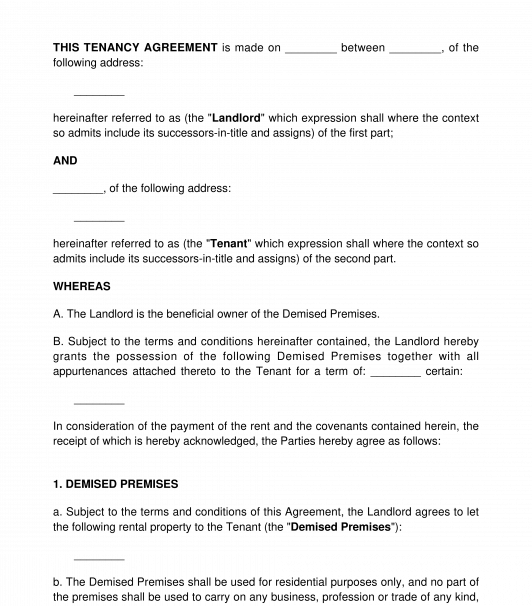A Residential Tenancy Agreement is an agreement between a landlord (the party who owns the property) and the tenant (the person acquiring possession of the property for rent) specifying the terms and conditions of the agreement such as the rent, the use of the property, the covenants of both parties, conditions for termination, etc.
This document is very similar to the Residential Lease Agreement, however, the Residential Lease Agreement is used to rent for a long term (usually more than three years), while this document is used to rent a property for a short term (usually for three years or less).
There are different forms of tenancies under the Nigerian law. The most popular ones are as follows:
- A periodic tenancy: This is a tenancy that has a commencement date but no end date. The tenancy continues until it is terminated by either the tenant or the landlord upon the issuance of a written notice. The forms of periodic tenancies are weekly tenancies, monthly tenancies, yearly tenancies, quarterly tenancies etc. The weekly tenant pays rent every week, the monthly tenant pays rent every month, the yearly tenant pays the rent every year and the quarterly tenant pays rent every three months until the tenancy is terminated. Upon termination by the landlord, the landlord must issue the tenant a Notice to Quit and a seven days owner's intention to recover possession. If the tenant intends to terminate the tenancy, the he/she should issue a Notice of Termination of Tenancy to the landlord.
- A fixed-term tenancy: This tenancy lasts for a specified period as agreed by the parties. In this case, once this period expires, the tenant is required to vacate the premises except the tenant renews the tenancy. Also, once the period of tenancy expires, the landlord does not need to issue a notice to quit (except in cases where the tenancy was terminated by the landlord before the expiration of the term). The landlord is only required to issue a seven days owner's intention to recover possession on the tenant.
How to use this document
This document is used by a landlord and tenant for the purpose of renting out premises for residential use only. It is used only when the term of the tenancy is less than 3 years.
The document outlines the following:
- Names and addresses of the parties: The parties to this agreement are the landlord and the tenant. The form filler must fill in the names and address of the landlord and the tenant.
- Details of the property: The rented property or demised premises is the residential building the landlord has agreed to let the tenant. The form filler must give full description of the property such as the size and the location.
- The rent: This is the amount which is payable by the tenant for the use of the property. Usually, if it is a fixed-term tenancy, the rent is paid once. While for a periodic tenancy, the rent is paid in equal installments (for example, a yearly tenant will pay the rent every year).
- Fixtures and fittings: They are items attached to the property for use by the tenant. These items include carpets, beds, paintings, mirror, furniture, air-conditioners, etc. The form filler is required to fill out all the fixtures and fittings, if any.
- Covenants: These are the legal promise made by both parties. This document contains certain covenants of the landlord, such as covenant to pay ground rent, to ensure the tenant enjoys peaceful possession, deliver the premises in good and habitable condition. Also, the document contains certain covenants of the tenant, such as covenant to pay the rent, to maintain the premises and always keep the premises in good and proper condition, etc.
- Termination: This document includes certain conditions for termination. For example, the length of notice required by the tenant or the landlord in cases where either of them chooses to terminate the tenancy.
After filling the form, the tenant should go through the agreement and sign two copies of this document. After this, the landlord should also sign the two copies and deliver one copy to the tenant. After the rent is paid, the landlord should issue a Rent Receipt (evidencing the payment of rent) to the tenant.
Applicable laws
In Lagos State, the following laws are applicable:
- The Tenancy Law, 2011: The law regulates the right and obligations under tenancy agreements. The law is applicable to all parts of Lagos, except Apapa, Ikeja GRA, Ikoyi and Victoria Island.
- Land Use Charge Law: The land use charge is a property tax that property owners are expected to pay.
Other applicable laws include: Registered Land Law, Land Registration Law, Capital Gains Tax Act and the tenancy laws of various States in Nigeria are applicable to this agreement.
How to modify the template
You fill out a form. The document is created before your eyes as you respond to the questions.
At the end, you receive it in Word and PDF formats. You can modify it and reuse it.
 10/01/2025
10/01/2025



 10/01/2025
10/01/2025
 Word and PDF
Word and PDF
 6 to 8 pages
6 to 8 pages


